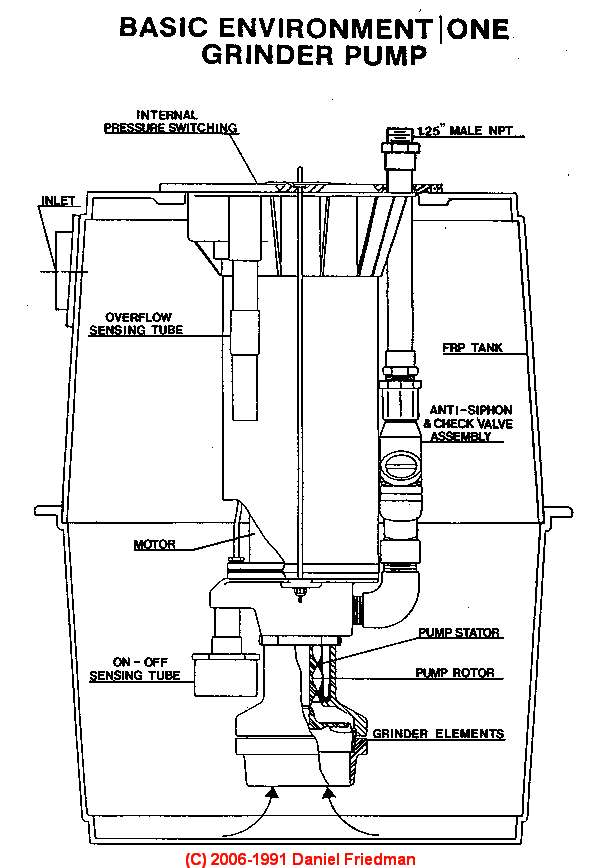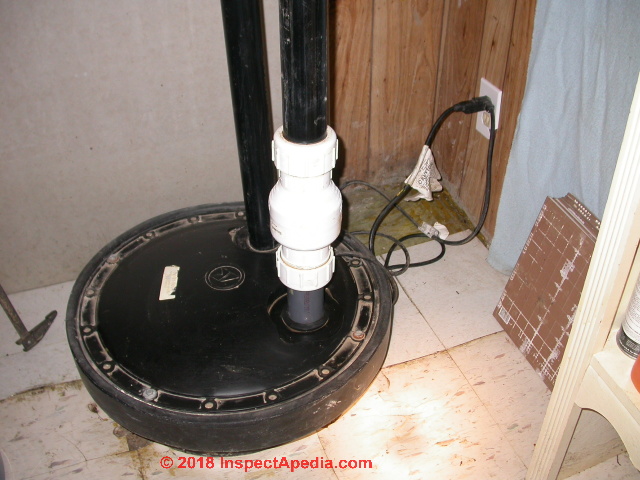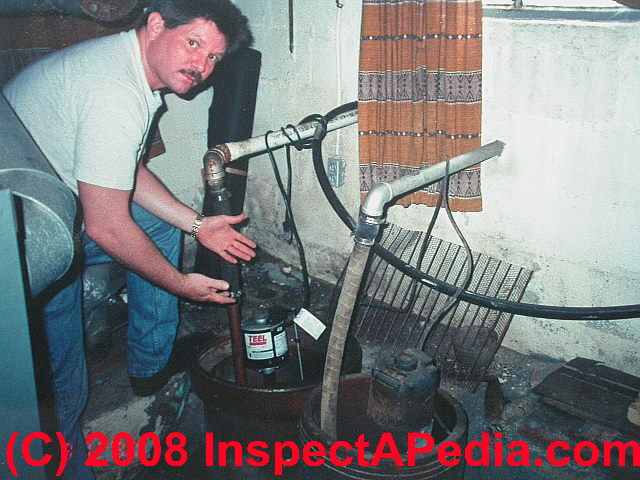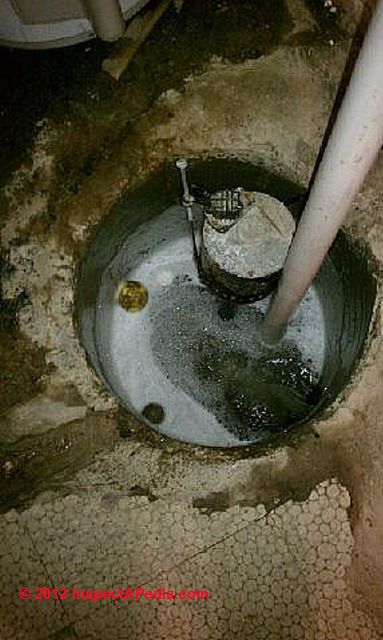 Septic & Sewage Pumps & Alarms
Septic & Sewage Pumps & Alarms
Types, uses, application guide
- POST a QUESTION or COMMENT about buying, installing, and repairing sewage ejector pumps and pump controls and about sewage and sump pump safety
This article explains the differences between Septic System Pumps and Sump Pumps , Sewage Ejector Pumps, Septic Grinder Pumps, Sewage Pumping Stations, & Septic Pump Alarms.
If you choose the wrong type of septic, sewage, effluent, or grinder pump you may find that your pump has a short life, clogs, or simply doesn't work.
Advice is given here for septic tank effluent or sewage pump selection and use.
InspectAPedia tolerates no conflicts of interest. We have no relationship with advertisers, products, or services discussed at this website.
- Daniel Friedman, Publisher/Editor/Author - See WHO ARE WE?
What are Septic Pumps, Sewage Grinders, Sewage Effluent Pumps, & Sump Pumps
 Here we define the types of septic system pumps and we give a warning about items that will clog septic pumps and grinder pumps as well as ot her safety warnings.
Here we define the types of septic system pumps and we give a warning about items that will clog septic pumps and grinder pumps as well as ot her safety warnings.
Photo: sewage ejector pump in the basement of a home inspected by the author.
Typically the piping connection from the ejector pump to the building sewer line is 2" and incorporates a check valve (the white valve shown in the front-right pipe in our photo ).
Septic pumps, sewage pumps, or sewage ejector pumps are designed to remove sewage from a building where plumbing fixtures and their drains are lower than the building sewer line and/or septic tank.
If you need to diagnose and fix a problem with your sewage or septic pump go directly to
To see our Septic Pump Alarm & Septic Alarm demonstration video
Definitions: septic or sewage pump, sewage-effluent pump and sump pump
First let's define the different types of pumps handling wastewater.
Here are the different types of wastewater pumps:
- A sewage pump, or sewage grinder pump or septic pump
moves blackwater (toilet waste) to lift it to a public sewer or to a private septic tank.
Any of these pumps may be used to lift or move blackwater (toilet waste) as well as graywater (sinks, showers, tubs, laundry) to a public sewer or to a private septic tank.
But designs and capacities to handle solid waste varies among types of these pumps, as we'll explain.
A sewage pump may be designed to either pass solids up to a certain size, or it may be a sewage grinder pump designed to macerate solid waste so that it can be pumped through a sewer line, perhaps a smaller diameter "force main" sewer line to a public sewer or to a septic tank.
Sewage grinder/ejector pumps are available in various horsepower models, typically from .5 to 1hp for residential applications, and are sold to operate at various voltages including 110-120V, 220-240V, 440-480V, and even 600V models using either single phase (most common) and three-phase motors.
Watch out: not all sewage pumps are grinder pumps, and even among grinder pumps the pump designs vary in just what solids they can handle by grinding.
See details at SEWAGE EJECTOR / GRINDER PUMPS - home
Still larger sewage pumps are used at municipal pumping stations that can handle wastewater from multiple buildings.
See details at SEWAGE PUMPING STATIONS
Watch out: a municipal pumping station will use a grinder pump that can even macerate small volumes of cloth and string or dental floss without clogging, but those elements in wastewater will clog and jam a typical residential sewage pump.
Septic pumps have to move solids by being able to pass large solid objects through the pump without clogging. Unlike a grinder pump, a simpler "septic pump" doesn't chop or grind the solid waste.
- A septic effluent pump,
pumps only clarified effluent or liquid, no large solid waste, to a disposal destination such as a septic mound system or to an aerobic septic effluent spray system.
Septic effluent pumps do not have to move solids, but are built to standards of durability and duty cycle more demanding than a typical sump pump used to remove ground water from a building.
Typical examples of applications where septic effluent pumps are used include raised bed, mound, or sand-bed filtration septic systems in which the absorption bed is located higher than the septic tank.
In these installations septic effluent is pumped from a final chamber in the septic tank or from a second effluent chamber up to the absorption system.
Watch out: PUMP MANUFACTURERS may show that the same pump models can serve as a sump pump, effluent pump, and de-watering pump.
But that is not universally the case - in other words, there are some sump pumps that work just fine as effluent pumps, but other sump pump models (such as low-cost sump pumps using a vertical float and rod switch and intended for indoor de-watering in basements) may not be suitable for septic effluent pumping and may not be designed to be used in a septic effluent tank or drywell.
Really? People use these terms loosely, and even among manufacturers it is important to ask, or read the manufacturer's description of what a particular pump model is intended to handle.
 Even among sewage pumps and grinder pumps that are intended to either pass solids or grind solids up and pump them, the vulnerability of different pump models to damage, clogging, or motor burn-up from debris that people may flush down drains and toilets varies by pump brand and model.
Even among sewage pumps and grinder pumps that are intended to either pass solids or grind solids up and pump them, the vulnerability of different pump models to damage, clogging, or motor burn-up from debris that people may flush down drains and toilets varies by pump brand and model.
A third type of pump is not intended for handling sewage or blackwater. My photo (below) shows a client asking why he has two duplexed sump pumps in the basement of the home he's buying.
Answer: there is a serious water entry problem in this building.
- Sump pumps
are designed to remove unwanted water, such as surface or ground water that leak into a building. Sump pumps only have to pump water, never solids.
A sump pump is normally installed in a pit at the low end of a basement or crawl space floor.
See details
at SUMP PUMPS - home
Sewage or Septic Pump Safety Warnings
 Watch out: dog and daughter fell into sump pit; dog died.
Watch out: dog and daughter fell into sump pit; dog died.
I recently moved in a house with this nasty hole in the basement.the first night my dog fell in and my daughter fell in the get the dog.2 hrs later the poor dog died but my daughter in ok.what can be put over this sump pump hole firmly so this does not happen again?
I am devastated for my dog but what if it was my 3yr ..my landlord was uncaring can you help! - T.C.
[A photo of the sump pit was subsequently provided by the reader - shown at left]
Reply: consult your doctor, inform your landlord in writing, look for other unsafe conditions
A competent onsite inspection by an expert usually finds additional information that can help understand just what the hazards are in your home, not just around the sump pit. Your email raises these concerns in my mind:
- What kind of "sump" are you talking about?
If this was a groundwater ejector pump or typical "sump pump" installation, the hazards may include injury, even drowning, as well as exposure to possible contaminants in groundwater;
if you are talking about a sewage ejector pump the hazards of bacterial and other pathogenic infections to your daughter and family are significant; in either case you should consult your family doctor immediately if your daughter was exposed to potential contaminants or sewage. - The inexperience or inattention that causes a building owner to leave a sump pit open, exposing occupants to a trip and fall hazard even if there are no other biological health hazards involved, leads me to suggest that there could be other safety hazards at the property.
While the topic is different, our advice to renters who encounter mold contamination at a property includes the importance of making sure that the building owner and manager know, in writing, of your concerns.
Details are at RENTERS & TENANTS GUIDE TO MOLD
Watch out:
- Block or rope off access around this hazard;
depending on the type of sump pit that was installed, there may be a prefabricated and safe cover that can be installed over the opening. Such covers are sold at building supply stores such as Home Depot and Loews.
Normally I'd expect that correction to be the responsibility of the building owner. But your first priority is to prevent another accident. - Inform your landlord of the accident and of this unsafe condition.
Please keep me posted on how things progress, and send along photos of the sump hole if you can. Such added details can help us understand what's happening and often permit some useful further comment. What we both learn may help me help someone else.
Reader Follow-Up:
These are the pics i have. And i have no idea what kind of pump it is.help me please. im scared for my kids.also little fly nat bugs are coming from it.
Comment:
 Your photos show an ordinary sump pump used to remove groundwater from below a basement slab and to carry off water that leaks into the basement, runs across the floor and enters the sump pit.
Your photos show an ordinary sump pump used to remove groundwater from below a basement slab and to carry off water that leaks into the basement, runs across the floor and enters the sump pit.
It also looks as if in most of the photos a sump pit cover was in place - so it would be useful to know if the cover has just been added, or was it left off, or how else did your daughter and pet fall into the pit?
From your photo [see covered sump pup pit photo above] it looks as if the pump and controls are so high in the sump pit that the cover, perhaps a home-made one, includes a large opening in its top through which a child or pet could step.
Also, one of your photos [photo of open sump pit shown at left] shows the sump pit with the cover off - and the water in your photo (it's a bit blurry picture) looks sudsy.
If the building dumps a laundry sink or washer into the pit and is then pumping that washer drainage to the ground surface outside, that'd most likely be a health and plumbing code violation.
Finally, it also looks as if the floor is broken up around the sump pit, perhaps to improve water entry into the pit from the floor surface? Is that uneven surface also a trip hazard.
Meanwhile, make sure the sump cover is secure and block off access to this corner to protect your family from trip and fall hazards.
How to Select the Proper Septic, Sewage, or Sump Pump Type
Now found at SEWAGE PUMP BUYERS GUIDE & MANUALS
Sewage ejector pump installation and maintenance are discussed in detail
at SEWAGE EJECTOR / GRINDER PUMPS
Septic pumps used for pumping air in aeration systems
and septic pumps used to move effluent in a drip dispersion system are discussed under the appropriate septic system type which are outlined
at SEPTIC SYSTEM DESIGN ALTERNATIVES.
Water removal pumps:
In a pinch we've seen people use SUMP PUMPS for septic tank effluent pumping but that is not a durable nor a recommended solution.
Sewage Pumps Clogging Failures
Details about cause and prevention of sewage pump clogging and damage have been moved to a separate article
at SEWAGE PUMP DAMAGE & REPAIR.
Watch out for the following conditions that cause clogging and even burnup of various types of sewage pumps, grinder pumps, ejector pumps, and septic pumps:
Don't Flush These Items Down the Toilet - They Clog or Burn Up the Grinder Pump
Details about what can and can't be flushed down toilets and what will foul or clog a sewage or grinder pump are now found
Producers of Septic Pumps, Sewage Pumps, Grinder Pumps, Effluent Pumps
Now found at SEPTIC PUMP BUYERS GUIDE & MANUALS
...
Continue reading at SEWAGE PUMP DAMAGE & REPAIR or select a topic from the closely-related articles below, or see the complete ARTICLE INDEX.
Or see SEPTIC PUMP FAQs - questions & answers posted originally at the end of this page.
Or see these
Recommended Articles
- ODORS, SEPTIC or SEWER
- SEWAGE EJECTOR / GRINDER PUMPS - home
- DISPOSABLE WET WIPE CLOGS
- FREE-STANDING GRINDER PUMPS
- SEWAGE TREATMENT PLANTS, RESIDENTIAL
- SEPTIC SYSTEM PUMPS
- SEPTIC PUMP ALARM SYSTEMS
- SEPTIC PUMP BUYERS GUIDE & MANUALS
- SEPTIC PUMP DUPLEX DESIGNS
- SEPTIC PUMP INSPECTION & MAINTENANCE
- SEPTIC PUMP INSTALLATION
- SEWAGE PUMP DAMAGE & REPAIR
- SEWAGE PUMP INTERMITTENT CYCLING
- SEWAGE PUMPING STATIONS
- SEWAGE PUMP BUYERS GUIDE & MANUALS
- SEWAGE PUMP DAMAGE & REPAIR
- SEWAGE PUMP ODORS
- SEWAGE ODOR SOURCE LOCATION
- SEWAGE PUMPING STATIONS
- WAXY BIOFILM SLIME CLOGS in DRAINS & PUMPS
- SEPTIC TANK PUMPING PROCEDURE
- SEPTIC TANK PUMPING SCHEDULE
- SUMP PUMPS
Suggested citation for this web page
SEPTIC SYSTEM PUMPS at InspectApedia.com - online encyclopedia of building & environmental inspection, testing, diagnosis, repair, & problem prevention advice.
Or see this
INDEX to RELATED ARTICLES: ARTICLE INDEX to SEPTIC SYSTEMS
Or use the SEARCH BOX found below to Ask a Question or Search InspectApedia
Ask a Question or Search InspectApedia
Try the search box just below, or if you prefer, post a question or comment in the Comments box below and we will respond promptly.
Search the InspectApedia website
Note: appearance of your Comment below may be delayed: if your comment contains an image, photograph, web link, or text that looks to the software as if it might be a web link, your posting will appear after it has been approved by a moderator. Apologies for the delay.
Only one image can be added per comment but you can post as many comments, and therefore images, as you like.
You will not receive a notification when a response to your question has been posted.
Please bookmark this page to make it easy for you to check back for our response.
IF above you see "Comment Form is loading comments..." then COMMENT BOX - countable.ca / bawkbox.com IS NOT WORKING.
In any case you are welcome to send an email directly to us at InspectApedia.com at editor@inspectApedia.com
We'll reply to you directly. Please help us help you by noting, in your email, the URL of the InspectApedia page where you wanted to comment.
Citations & References
In addition to any citations in the article above, a full list is available on request.
- [1] Weinman Installation and Operation Manual, Submersible Sewage Ejector Pump, Crane Pumps and Systems, 420 Third Street, Piqua, Ohio 45356 Phone: (937) 778-8947 and Crane Pumps and Systems,
83 West Drive, Bramton,
Ontario, Canada L6T 2J6,
Phone: (905) 457-6223
Fax: (937) 773-7157 Fax: (905) 457-2650
www.cranepumps.com.
See Weinman submersible sewage ejector pump installation and service manual for an example instructions for the Weinman Series WE and 3WE sewage ejector pumps ranging from .5 to 1 hp. Web search 8/9/11, original source: http://www.cranepumps.com/downloadables/CATALOGS_OIPMs/
Manuals%20&%20Instruction%20sheets/108038.pdf - [2] Grundfos Sewage Ejector Pump Package Installation and Operating Instructions, Grundfos Pumps Corporation, 2555 Clovis Ave., Clovis CA 93612, Tel: 800-333-1366, web search 8/9/11,original source
http://www.us.grundfos.com/web/download.nsf/Pages/
7C03990D6E09EC6C882565220069C131/$File/Seeje-io.pdf - [3] Submersible Sewage Ejector Pump Installation, Operation, & Parts Manual, by Hydromatic Pentair Water, 740 East 9th Street, Ashland, OH 44805,
Phone: 1-888-957-8677,
Web Site: http://www.hydromatic.com - [4] The Sewage Pumping Handbook, Grundfos, web search 11/30/2011, original source: http://www.grundfos.com/content/dam/Global%20Site/Industries
%20%26%20solutions/waterutility/pdf/sewage-handbook.pdf - In addition to citations & references found in this article, see the research citations given at the end of the related articles found at our suggested
CONTINUE READING or RECOMMENDED ARTICLES.
- Carson, Dunlop & Associates Ltd., 120 Carlton Street Suite 407, Toronto ON M5A 4K2. Tel: (416) 964-9415 1-800-268-7070 Email: info@carsondunlop.com. Alan Carson is a past president of ASHI, the American Society of Home Inspectors.
Thanks to Alan Carson and Bob Dunlop, for permission for InspectAPedia to use text excerpts from The HOME REFERENCE BOOK - the Encyclopedia of Homes and to use illustrations from The ILLUSTRATED HOME .
Carson Dunlop Associates provides extensive home inspection education and report writing material. In gratitude we provide links to tsome Carson Dunlop Associates products and services.

